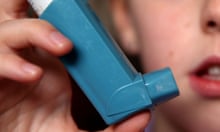Almost 67,000 new cases of asthma in children across 18 European countries could be prevented every year if levels of tiny particulates polluting the air are cut to recommended levels, research suggests.
The study joins a growing body of research into the impact of air pollution on human health. A landmark study published in April estimated that 4m new asthma cases a year globally among those aged one to 18 were down to levels of nitrogen dioxide (NO2) in the air.
The latest study, which focused on asthma diagnoses among children aged one to 14, looked at components of toxic air including fine particulate matter known as PM2.5 as well as NO2, both of which are released by road vehicles and sources.
“A considerable proportion of childhood asthma is actually caused by air pollution, particularly PM2.5,” said Dr Mark Nieuwenhuijsen, from the Barcelona Institute of Global Health (ISGlobal) and a co-author of the research.
The study shows thousands of new cases of asthma could be prevented each year by adhering to guidelines set by the World Health Organization (WHO), but Nieuwenhuijsen and his colleagues write that there is more to do. Evidence suggests there is no threshold level when it comes to the impact of air pollution on health, they say.
Writing in the European Respiratory Journal, the team describe how they focused their study on 18 European countries, including France, Denmark, Spain, and the UK. They used a range of data including national-level figures for childhood asthma incidence, estimates of the distribution of children across the countries and the levels of pollution they are exposed to.
In total the team’s estimates encompassed more than 63.4 million children.
According to WHO guidelines, levels of PM2.5 should not exceed an annual average of 10 μg/m3, and levels of NO2 should not exceed an annual average of 40 μg/m3.
Q&AHow does air pollution affect the human body?
Show
Air pollution has been described as the ‘new tobacco’ by the head of the World Health Organization. Over 90% of the world’s population suffers toxic air and research is increasingly revealing the profound impacts on the health of people, especially children.
Children and babies’ developing bodies are most at risk from toxic air, with 300 million living in places where toxic fumes are six times above the international guidelines.
A comprehensive global review found that air pollution may be damaging every organ and virtually every cell in the human body. It causes issues from heart and lung disease to diabetes and dementia, and from liver problems and bladder cancer to brittle bones and damaged skin. The systemic damage is the result of pollutants causing inflammation that then floods through the body, and from ultrafine particles being carried around the body by the bloodstream. A Canadian study recently linked air pollution nanoparticles to brain cancer for first time
In the UK, while deaths attributed to air pollution have halved in the last four decades, most urban areas have illegal levels of air pollution. One in 20 deaths in the UK is still attributable to small particle pollution alone.
Damian Carrington, Environment editor
The new study suggests that, if the 18 countries in the study were to stay within these limits for PM2.5, 66,600 new cases of childhood asthma, accounting for 11% of new diagnoses, would be prevented each year, about 10,400 of which would be in the UK. Around 2,400 new cases would be prevented each year across the 18 countries if WHO limits for NO2 were not exceeded.
The team found even greater effects when they set air pollution levels to the lowest ever recorded in studies – a sort of “background measure” which was recorded in Germany for PM2.5 and in Norway for NO2. The estimates suggest a third of new childhood asthma cases – around 190,000 a year – would be prevented if PM2.5 fell to such levels across the 18 countries, and 23% of cases would be prevented if NO2 was reduced to its lowest recorded levels.
“It is not really realistic at the moment to get down to these levels, but it just gives an [estimate of] how many cases actually may be attributable to [these pollutants],” Nieuwenhuijsen said.
“What is clear from our analysis is that current WHO standards are not strict enough to protect against many cases of childhood asthma,” he said, noting WHO guidelines were currently under review.
Prof Stephen Holgate, a special adviser on air quality for the Royal College of Physicians, said the study showed meeting WHO air pollution limits would create a “massive health gain”.
“This groundbreaking study confirms the massive impact that air pollution has on childhood asthma, not only in making it worse in those who already suffer, but initiating new asthma,” he said, adding that the UK had one of the highest prevalences of asthma worldwide.”
Dr Susan Anenberg from George Washington University, a co-author of the global study published in April, said the latest research was another indication of the damage air pollution could do to public health. “Almost no one on planet Earth breathes clean air,” she said.
“The good news is that there are many ways to prevent children from getting asthma because of their air pollution exposure. Making it easier to cycle, walk or run to get places, for example, has many benefits for society – including improved air quality, increased physical activity and less climate-warming pollution.”
Dr Penny Woods, the chief executive of the British Lung Foundation, said the best way to tackle urban air pollution was by reducing the most polluting vehicles through clean air zones.
“We also need the government to urgently commit to reaching World Health Organization guidelines for fine particulate matter, the most dangerous type of air pollution,” she said.









